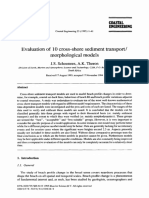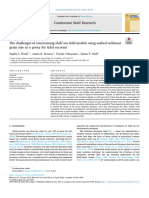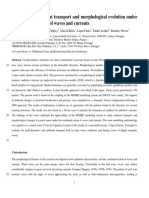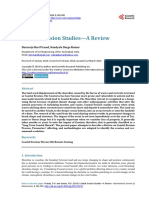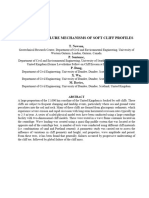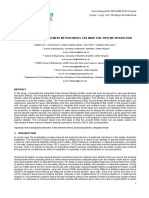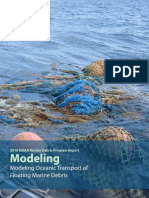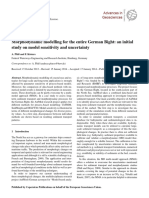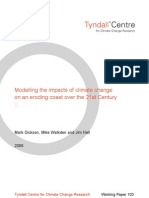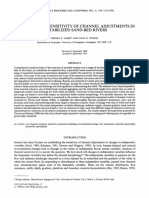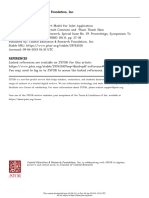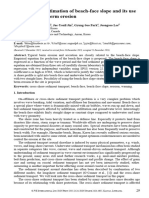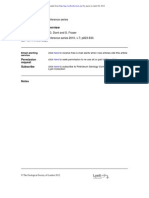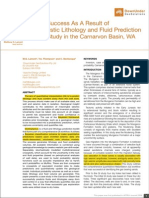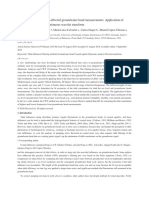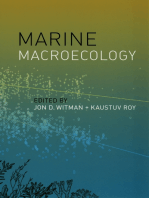Large Scale Experiments On Gravel and Mixed Beaches
Large Scale Experiments On Gravel and Mixed Beaches
Uploaded by
robertlf2Copyright:
Available Formats
Large Scale Experiments On Gravel and Mixed Beaches
Large Scale Experiments On Gravel and Mixed Beaches
Uploaded by
robertlf2Original Title
Copyright
Available Formats
Share this document
Did you find this document useful?
Is this content inappropriate?
Copyright:
Available Formats
Large Scale Experiments On Gravel and Mixed Beaches
Large Scale Experiments On Gravel and Mixed Beaches
Uploaded by
robertlf2Copyright:
Available Formats
1
Large scale experiments on gravel and mixed beaches: Experimental procedure, data documentation and initial results
Belen Lpez de San Romn-Blanco, Tom T. Coates1, Pat Holmes2, Andrew J. Chadwick3*, Andrew Bradbury4, Tom E. Baldock5, Adrin Pedrozo-Acua3, John Lawrence3, Joachim Grne6
1 HR 2
Wallingford, Howbery Park Wallingford, OX10 8BA, Oxon, United Kingdom
Department of Civil and Environmental Engineering, Imperial College of Science, Technology and Medicine, London, SW7 2BU, United Kingdom
University of Plymouth, Centre for Coastal Dynamics and Engineering, School of Engineering, Drake Circus, PL4 8AA, Plymouth, United Kingdom
4 5
Channel Coastal Observatory, Southhampton, United Kingdom
Department of Civil Engineering, University of Queensland, Brisbane, Queensland, Australia
Coastal Research Centre (FZK), University Hannover and Technical University Braunschweig, Merkurstrasse 11, 304019, Hannover, Germany
Abstract This paper provides information on the experimental set-up, data collection methods and results to date for the project Large scale modelling of coarse grained beaches, undertaken at the Large Wave Channel (GWK) of FZK in Hannover by an international group of researchers in Spring 2002. The main objective of the experiments was to provide full scale measurements of crossshore processes on gravel and mixed beaches for the verification and further development of cross-shore numerical models of gravel and mixed sediment beaches. Identical random and regular wave tests were undertaken for a gravel beach and a mixed sand/gravel beach set up in the flume.
*
Formerly HR Wallingford, Howbery Park Wallingford, Oxon, United Kingdom Corresponding author:
Email: achadwick@plymouth.ac.uk Fax: + 44 1752 23 26 38
2 Measurements included profile development, water surface elevation along the flume, internal pressures in the swash zone, piezometric head levels within the beach, run-up, flow velocities in the surf-zone and sediment size distributions.
The purpose of the paper is to present to the scientific community the experimental procedure, a summary of the data collected, some initial results, as well as a brief outline of the on-going research being carried out with the data by different research groups. The experimental data is available to all the scientific community following submission of a statement of objectives, specification of data requirements and an agreement to abide with the GWK and EU protocols. Keywords: Shingle beach, gravel, mixed beaches; large-scale experiments, GWK, physical model, morphology
Rationale
The majority of existing research into coastal morphodynamics in the last twenty years has been concerned with sandy beaches. Little research has been devoted to gravel beaches and even less to mixed beaches, which results in this research field being in a stage of early development, or for some issues no development. Management issues such as storm response or the long-term stability of gravel and mixed beaches demand new observations and new methodologies to predict morphological behaviour. Mixed beaches containing sediment sizes ranging over several orders of magnitude (sand to gravel) are increasingly seen as being important to coastal engineers and managers around the world. These practitioners have expressed their concerns about the difficulties in dealing with such beaches with available predictive tools. Such beaches are often barrier beaches protecting important backshore infrastructure or agricultural areas.
In order to develop a management strategy for a section of coastline, it is important to consider the likely response of beaches both under long term and storm conditions. The prediction of the profile development during
storms can be carried out using either physical models or numerical models. Although acceptable approaches to scaling narrow graded gravel beaches have been used for over twenty-five years (see Powell, 1990), small scale modelling of beaches with a mixture of sand and gravel is limited because of the incompatibility of having both fractions within the same model. Numerical approaches are broadly divided into parametric models, often derived from observed results in the laboratory or from field measurements, and physics based models which attempt to account explicitly for the main physical processes active across the foreshore. Each of these approaches has weaknesses and strengths, but none is able to simulate all of the important and complex processes influencing mixed beaches. Most numerical models have been derived for sand beaches and have then been extended to include a wider range of grain sizes. The main problems with respect to extending these models to mixed beaches are set out in Mason and Coates (2001) and Lpez de San Romn-Blanco et al. (2000) and arise from the assumptions of a simplistic description of beach sediment, usually defining the complete beach by a single D50 value and ignoring flows within the beach face.
For longshore sediment transport both process models (Damgaard et al., 1996) and empirical models, such as the CERC formula, Brampton and Motyka (1984) or Damgaard and Soulsby (1996), provide reasonable results. Van Wellen et al. (2000) provides a comprehensive review of the different longshore transport formulae available and their applicability to coarsegrained sediments, as well as an inter-comparison of the different formulae. They found that the most accurate predictions were from formulae previously validated at sites similar to that used for the subsequent comparison, and
4 therefore required further testing against field data from dissimilar sites before their accuracy could be assessed properly.
In contrast, cross-shore numerical models have had limited success mainly due to a lack of knowledge of the governing physical processes and/or an inability to model the processes adequately. Hence no process-based model is available to predict the morphological response of a coarse grained or mixed beach to a given hydrodynamic forcing. Research work aimed at filling this gap had been started prior to the experiments by some members of the research team associated with this study. HR Wallingford had been working on the extension of OTTP-1D (one-dimensional swash zone model with a porous layer) towards a morphological capability (Clarke and Damgaard, 2002). The University of Plymouth had been working on the coupling of a 1-D phase resolving numerical wave model (based on the weakly non-linear Boussinesq equations) with a sediment transport module and a
morphodynamic module (Lawrence et al., 2003). The sediment transport module includes a hiding function to estimate the sediment transport for different sediment size fractions and tracks the changing sediment composition over the profile with time.
At present, the coarse grained profile empirical or parametric models available are those of Powell (1990) known as SHINGLE, and BREAKWAT, by van der Meer (1988), based on extensive scaled laboratory flume tests (small scale with anthracite in Powells and large and small scale with gravel in van der Meers). The main factors influencing gravel beach profiles are, according to Powell (1990) and van der Meer (1988), wave height, wave period, wave duration, beach material and angle of wave attack. Parametric models for mixed-grained beaches do not exist at the moment.
Several major field measurement programmes, including the UK Shingle Beach Project (e.g. Van Wellen et al., 1997), beach field work by Imperial
5 College, (e.g. Blewett et al., 2001) and the EU Coast 3D project (Soulsby, 2001) have provided a range of useful data. In common with all field research, the results of these programmes are limited by the specific site characteristics and the uncontrolled sea conditions. Holmes et al. (1996) presented small scale tests of the profile evolution of fine, coarse and mixed sand beaches, including beaches with different mix ratios. They also examined the post response distribution of sediment and found that the finer sediment tended to be deposited or exposed in the most energetic regions, e.g. at the crest of the bar and in swash zone. However, there are scaling uncertainties associated with small scale mobile bed models. These can be avoided in large-scale (1:1) flume tests while at the same time retaining the advantages of controlled wave and water level conditions.
In order to address this issue, the EU project Large Scale Modelling of Coarse Grained Beaches was undertaken between March-May 2002, with the main objective to provide data for the verification and further development of numerical models describing the profile evolution of mixed sediment and coarse grained beaches. A secondary aim was to obtain more detailed data on nearshore hydrodynamics and beach groundwater, both difficult to achieve in the field for these types of beach.
The project team was composed of members of the Steering Group (SG) and Research Team (RT). The project was led by HR Wallingford (Tom Coates, project manager; Beln Blanco, senior researcher and Jesper Damgaard, SG) and included members of Imperial College, UK, (Prof. Pat Holmes, SG and Dr. Tom Baldock, SG), University of Plymouth, UK, (Prof. Andrew Chadwick, SG, John Lawrence, RT and Adrin Pedrozo Acua, RT), University of
Southampton, UK, (Prof. Andrew Bradbury, SG and Maurice Mc Cabe, RT), New Forest District Council, UK, (Prof. Andrew Bradbury, RT), University of Caen, France, (Prof. Frank Levoy, SG) and University of Firenze, Italy, (Prof.
6 Enzo Pranzini, SG). During the experiments in the GWK the Research Team was assisted by the FZK staff.
The test program was designed to provide the following data sets: beach profile change for different sediment types under a range of
wave conditions hydraulic gradients within the beach face, both above and below the
still water line cross shore and vertical velocity distributions within breaking waves
and the swash zone cross shore and vertical changes in sediment distributions following
wave exposure.
More detailed information about the experiments and the data can be found in Lpez de San Romn-Blanco (2002).
The data derived from the test programme will be useful to the many European researchers interested in beach response modelling. The future developments resulting from this work have the potential to raise coarsegrained and mixed beach transport modelling to a new level of confidence, with benefits to coastal engineers and coastal zone managers throughout the world.
The remainder of the paper is organised as follows: Section 2 of the paper presents the experimental procedure and set-up, where a description of the flume, beaches and measuring techniques is given. Section 3 describes the test programme undertaken for each beach and the characteristics of each test. Information about how the data was collected and stored is given in section 4, while section 5 presents representative results of the experiments. Section 6 gives a summary of the analysis and research carried out to date with the experimental data. Section 7 presents the main conclusions to date.
2
2.1
Experimental procedure and set-up
Introduction
The experiments were carried out at the GWK (Grosser Wellenkanal Large Wave Channel), which is described in Section 2.2 (see Plate 1).
The experiments ran for nearly 3 months during Spring 2002 and consisted of 2 phases: Beach I - gravel only; consisting of construction of Beach I,
instrumentation set up and calibration and Beach I testing Beach II mixed; consisting of demobilisation of Beach I, construction
of Beach II, instrumentation set up and calibration and Beach II testing
Identical random and regular wave tests were undertaken for the Gravel Beach and the Mixed Beach. Measurements included: profile development, water surface elevation along the flume, internal pressures in the swash zone, internal set-up, run-up, velocities in the surf-zone and sediment distributions. This experimental exercise was complemented with a series of full-scale beach deployments at sand, gravel and mixed sediment beaches at three locations in the UK (see Holmes et al., 2002).
2.2
The GWK flume
The GWK is a 309m long, 7m deep and 5m wide flume in the FZK (Coastal Research Centre), which is a joint central institution of the University of Hanover and the Technical University Braunschweig and situated in Hanover, Germany. The flume has a permanent 1:6 asphalt permanent slope (see Figure 1), over which the sediment was placed. The facility is equipped with a mobile instrument carriage (shown in Plate 1), overhead lifting gantry and a 2m wave capability wave paddle plus a range of instrumentation. Further details can be found in Dette et al. (1998).
2.3
Beach construction
For both beaches (Beach I- Gravel only and Beach II-Mixed) an initial profile of 1:8 was placed over the asphalt permanent slope of 1:6, the minimum depth of the beach being 2m (see Figure 1). At the toe of the beach three sloped concrete structures were placed to minimise loses of sediment (especially sand) towards the wavemaker.
Although the two beaches were initially constructed at a 1:8 slope over the asphalt permanent slope, they were not reshaped during the experimental procedure, so that the initial condition for each test was the final profile from the previous test. Although it is acknowledged that this procedure can introduce some uncertainty due to an extra variable, the initial condition for each test, it is commonly assumed to be acceptable. Reshaping the beach in such a large facility would have been very time consuming and therefore not practical, and there are also uncertainties as to an appropriate initial condition in any event. Beach I - Gravel only The gravel used had a size between 16 and 32mm, with a mean diameter of D50gravel=21mm. Although the gravel was not as rounded as that found on natural beaches (it was rounded material from interglacial rivers), it was considered to be within acceptable limits of angularity. The beach porosity was approximately 0.44.
Beach II Mixed beach The sediment used consisted of a bimodal mix between the 21mm gravel and sand with a D50sand=300m. The desired mix of the sediment was 30% sand and 70% gravel, representative of natural mixed beaches (Lpez de San Romn-Blanco, 2003). When demobilising Beach I, the gravel was thoroughly
9 mixed with the sand outside the flume. When placing the mixture back in the flume it was then further mixed with the bucket of the machine in order to achieve a uniform mixture before being shaped.
Pre and post test sediment sampling was carried out to verify the mix ratio (see section 2.6). For the initial mixed beach, the porosity was lower than for the gravel beach, at around 0.2. However, as the beach sediment was redistributed under wave attack, the porosity also changed, adopting values between 0.4 and 0.2, depending on the amount of sand present in the sample. Figure 2 shows the initial sediment size distribution for both beaches.
Construction issues For the construction of the beaches a number of factors had to be considered. Whilst it was important to construct the beach in the most realistic manner, the logistical difficulties of transporting large quantities of gravel material had to be accounted for. The compaction of material by the machinery carrying the sediment raised issues such as the uniformity of beach construction across the length and breadth of the flume. These and other issues are discussed in more detail in this section:
Quantity of materials used: It is estimated that a total of 860 tonnes of
gravel were placed to cover a volume of approximately 600m3 (see Figure 1) for Beach I gravel only. For Beach II (mixed) it was anticipated that the entire quantity of gravel from Beach I would be used to form the equivalent slope for Beach II (i.e. the sand would permeate into the gravel pores). However, it is important to note that not all the gravel was used to form Beach II. Unfortunately, it was not possible to estimate the quantity of Beach I gravel that remained due to complicated storage issues.
Compaction: For both beaches, visual observation showed the
sediment to be compacted due to the machinery used in the construction.
10 Also, due to the instrumentation on the right side of the flume, the machinery drove over the centre and left side. This resulted in a different compaction of the sediment across the flume. It is considered likely that this compaction was the cause of some of the irregularities across the flume seen during the experiments, especially in Beach II.
Settlement: Beach II (mixed) appeared to be quite compacted at the end
of the construction. However, the flume was filled with water over 1 day and left 1 day before carrying out the probe calibration. During this time, it was apparent that some settlement had taken place as evidenced by previously covered instrument becoming exposed.
2.4
Instrumentation
The following instrumentation was used in order to measure the hydrodynamics:
Wave gauges: A total of 25 capacitance wire wave gauges (wg) were
placed along the flume to record water surface elevations. The locations of the fixed wg (16 to 24) are shown in Figure 1. The exact position of all gauges as well as their vertical range (upper and lower recording range) is given in Table 1. The position of wg 25 was variable during the experiments as it was mounted on the mobile carriage.
Pressure Transducers: A total of 24 Druck pressure transducers (pts)
were deployed in the beach. Figure 1 shows the position of both sets of pts and Table 2 gives the characteristics of each probe and their position. Their deployment was divided in 2 sets:
Arrays of pts. These consisted of 5 arrays of 4 pts, each deployed in the beach within the swash zone. Each array was mounted of
11 a 100mm wide x 500mm long plastic board with special fittings to hold the pts every 100mm. At the bottom end of each board two metal spikes were used to position and fix the board in place in the sediment. At the top end, a 500mm long spike was attached in order to be able to see the position of the array once covered with sediment. These arrays were deployed in order to measure pressure propagation within the swash zone due to flows over, in and out of the beach. Plate 2 shows the pt arrays in place prior to final burial in the beach.
Buried pts. These consisted of 4 pts mounted on the permanent flume asphalt floor (impermeable slope in the figures) further up in the beach. They were set up in order to see the variation of the piezometric head in that area. These pressure transducers were deployed in special filtering devices used at the GWK to avoid any influence from pressures directly between the sand particles (using the pressure cells as real pore-pressure sensors). Plate 3 shows the buried pts in place before being covered.
Mobile array: ADVs and Hydrophone: A mobile instrument array was
mounted on the carriage (see Plate 4), enabling this station to be moved within the surf and swash zone (chainages 250m-262m) during the tests, with a total of 4 to 7 different positions investigated for each test. The instruments consisted of: An array of 3 acoustic Doppler velocimeters (ADV), vertically separated by 200mm. The bottom-most ADV head was placed at 300mm from the bottom of the array. These ADVs had a 2.5m/sec velocity range, which proved not to be sufficient in several cases. A wave gauge (wg 25).
12 A hydrophone, situated in between the two lower ADVs, at 400mm from the bottom of the array.
Run-up: Maximum run-up elevation was recorded with a video for all
the tests. A grid had been painted in the wall of the flume in order to facilitate the readings. The grid can be seen in Plate 1.
Calibration In order to calibrate the wave gauges and pressure transducers, the water level at the flume was varied in stages. For each water level, voltage readings were taken for a total of 180s at 30Hz frequency for the pts and wgs. At the same time, the water level oscillations were monitored. At the end of each test the mean water level and the mean voltage reading over the 180s were calculated. A total of 13 different water levels were recorded, at the end of which regression line between average voltage readings and average water levels was drawn. The calibration parameter for each probe is taken from this regression line.
2.5
Wave conditions
The majority of tests comprised a total of 3000 waves. These waves however, were not run as a continuous time series but as a series of batches. The length of the batches varied in response to the rate of morphodynamic changes (see section 2.5).
Wave generation An important aspect of the experiments was the wave generation, as disturbances and primary reflections should be excluded in order to have accurate generated waves. The paddle (pusher type motion) of the wave generator at GWK is equipped with an online absorption control system,
13 which enables the compensation of all kinds of reflections directly at the wave paddle (Schmidt-Koppenhagen et.al. 1997). The JONSWAP spectral shape was chosen as the reference spectrum for all the irregular test series.
Usually, long duration random wave simulations were used to ensure that a wide spectrum of wave heights and periods were generated for a given test duration. However, for extreme wave conditions, the largest waves for a specified Hs would have exceeded the wavemaker capability. Consequently, for certain tests, the generated waves consisted of the repetition of the shorter time series with equivalent Hs but smaller maximum wave height. Note that the total generation time included a small period for ramping the wavemaker signal up and down at the beginning and the end of each test. This period was set to four times the peak period.
2.6
Morphology
In order to see the morphodynamic response of the beach, profile measurements were taken after each wave test. Sediment samples at different positions along the flume were taken while the profile was observed to be changing significantly and at the end of each wave test, when the profile was assumed to have reached an equilibrium position.
Profile measurements Profile measurements were carried out with the GWK mobile carriage. The profiler consists of a 7.5m long beam equipped with three parallel mounted plastic rollers. The angular position of the beam is recorded and converted into position and elevation information. (Details of its mechanical system can be found in Berend et al., 1997). Plate 1 shows the profiler beam (not in operation) while the experiments were running.
14 This device allows a quick (around 10m/minute) profiling after a single test, without having to drain the flume or have disturbances due to changing water level. These profiles were always taken down the centre of the flume. The profiler measurement error in the vertical is estimated to be 50mm (approximate 95% confidence interval). Noting that the mean size of the gravel was 21mm, such accuracy was deemed sufficient.
Sediment sampling Surface sediment samples were collected at early stages of the profile development (normally, after 500 waves) and at the end of each test. Samples were taken with a shovel at three different positions; at the beach step, at the SWL and at the crest of the berm formed by each wave condition. The location of the beach step was deduced from the profile taken, visual examinations of the breaking zone and the interpretation of the person performing the sampling.
For beach II (mixed sediment), samples at different depths were also collected for the SWL and crest positions at the end of each wave test. These samples were taken from the base of the hole left by the removal of sediment with the large grab suspended from the mobile gantry. The base of the hole was levelled to determine the sample depth. Although disturbance of the
sediment in the area is high, it is believed to be reasonable, due to the fact that in-depth samples are taken at least every 3000 waves.
Samples weighed an average of 7kg; they were dried for 24 hours in an oven and then sieved. Sieves covered the gravel mode: 31.5mm, 24mm, 16mm, 8mm and 2mm. The sand was treated as only one fraction and not sieved. Although it is understood that the sand may have also sorted out during the experiments, the effort of sieving it into different fractions was not considered necessary for the purposes of our experiments.
15 Post-experiment sampling At the end of the tests for Beach II (mixed), additional sampling was carried out to record the sub-surface sediment distribution across the beach. Firstly, the surface layer of gravel was scraped with a mini-digger from the top of the beach for approximately 20m of the profile length. As can be seen from Plate 5, the interface between the superficial layer of gravel and the mixed sediment was notably sharp and easily identified, also a feature of natural beaches. The interface was then profiled to obtain the depth of the mixed layer. Subsequently, a trench of approximately 300mm depth was dug to investigate the variation in sediment distribution along the flume. Finally, two sampling pits were dug at two different chainages and three samples were taken at different depths.
Test Programme
A matrix of tests was developed that enabled a full range of parameters to be compared. The first entrance of the matrix, target wave steepness (H/L), adopted three different values: 0.05 (series 1), 0.03 (series 2) and 0.015 (series 3). The second entrance, target significant wave height (Hs), took values of 0.6m, 1.0m or 1.2m. However, there were uncertainties regarding the total number of tests that could be completed in the allocated flume time. Core Programme To ensure that a good range of parameters was covered, a core programme was developed. The core programme consisted of 5 different random wave tests and 2 regular waves tests (shown in Table 3). Wave Test 1 was also repeated in order to investigate the effects of the initial plane shape on overall profile development. All these tests had a constant water level of 4.7m. This core programme was completed for Beach I and II.
16 Additional tests for Beach I- gravel only The core tests for Beach I were completed in good time, which enabled 3 additional tests (Tests 6, 7 and 8) from the matrix to be carried out. (Test 9 was not carried out, as the beach would have grown well over the top of the flume). These additional tests are shown in Table 3 in Italics.
Additional tests for Beach II- mixed The core tests for Beach II were also completed in good time. However, additional tests for this beach were not the same as for the gravel only beach. The reasons for this were the incorporation of some of the comments from the experts group meeting and the fact that the beach composition was partially changed at the end of the core testing for Beach II . For Beach II (mixed) the additional tests were the following:
Test 10 Erosive condition. Wave Test 2 target conditions (Hs=1m,
Tp=4.14s) were run for a lower water level (SWL=3.4m). The reason behind this experiment is that only accretion profiles had been seen during the core testing. As the tests were run from milder to more severe conditions, the profiles developing to get in equilibrium with the new condition mostly meant accretion at the berm.
Test 11 Tidal condition. In order to see the effects of varying tidal
levels and as a first approximation of tide modelling, the water level was varied in stages for Wave Test 2 target conditions (Hs=1m, Tp=4.14s). A total of 9 steps were investigated as an approximation of a tidal cycle from SWL to high tide and back to SWL.
Test 12 Tidal condition. A different wave condition (Wave Test 4
with target conditions of Hs=1m and Tp=5.29s) was investigated in the same way as Test 11.
17 3.1 Sequencing
Each wave test was run in batches in order to enable measurement of the morphodynamic response over time. At the beginning of the wave test, batches of small numbers of waves were run, as important changes in the profile occur at the beginning. The number of waves in the batches increased as the profile developed towards equilibrium and changes reduce in magnitude. A usual sequence for a wave test was: 50, 450, 500, 1000, 1000 waves; total number of waves in this case being of 3000. For beach II (mixed) the total number of waves was usually bigger as the profile took longer to develop. In Table 4 the batches used in each wave test have been indicated. Note that the table is in chronological order so that the sequencing of the different wave tests can also be extracted from it. Also, Table 4 contains information on the time intervals at which profile measurement and sediment sampling were carried out.
Data collection and Storage
PRESTON data. This comprises the data directly logged into the
Collected data can be divided into two categories:
AC/DC board and collected with the GWK PRESTON data acquisition program. This data was logged at 60Hz with 57 channels having been used in this experiment. It includes the wave gauges, pressure transducers and ADV data. Each channel data are kept in a file named after the date, the experiment number and the channel number. Each file contains a digit for each 1/60th of a second
Other data. This comprises all the other data that was not collected with It includes the hydrophone,
PRESTON and therefore not synchronised. profile, video and sampling data.
Profile data: The measured profile is given in a series of spreadsheets. The data are stored as a couple of columns, the
18 first one representing the position in the flume whereas the second one describes the profile height above the channel floor in meters. Sampling information: Information on location of the samples and the samples sediment distribution can be found in a spreadsheet containing the results from the sieving exercises.
Results
Representative results of the experiments are presented in this section in order to provide the scientific and engineering community with an example. Beach I Gravel Beach wave test 4 (with the characteristics shown in Table 4) has been selected as representative and time series of the measurements during this test are given in this section. For representation purposes, sequence 4a (the shortest in terms of number of waves) has been selected for most of the cases.
Figure 3 shows the profile evolution for Test 4 (Beach I Gravel) after each batch of waves, so that the morphological development of the beach can be appreciated. Also, a small plot containing the initial and final profile has been included (upper-left corner) in order to provide the total balance of material moved for that test.
Figure 4 shows the water surface elevation time series as recorded by one of the wave gauges (wg 5) during the duration of Test 4a (Beach I Gravel). In this figure the ramping up and down of the waves, as well as their random characteristic is easily seen.
Figure 5 shows a time series of the currents as measured by the ADVs for Test 4b (Beach I Gravel).
19 Figure 6 shows the subsurface pressure time series for Test 4a (Beach I Gravel). For representation purposes, only the pressures measured by the first array of pressure transducers is shown. These pressures are represented in terms of absolute head of water. These absolute heads measured at the same horizontal position but different vertical positions are separated by 0.1m, which accounts for the hydrostatic pressure change among them.
Figure 7 shows the internal set-up time series for Test 4a (Beach I Gravel) as measured by the buried pressure transducers. In this case the 4th buried pressure transducer did not record any signal. The internal set-up is represented as head of water measured.
In Figure 8, a summary of the measurements carried out during Test 4c (Beach I Gravel) is shown. They are represented imagining that the reader is looking into the flume through a window; being able to see the measurement devices as well as the measurements taken. These measurements include: Wave envelope: The envelope of the mean wave height (Hm0) as
calculated for each wave gauge. Set-down: measured mean sea level for each wave gauge Sub-surface head: mean sub-surface heads of water (measured relative
to a datum taken at the bottom of the flume) as calculated for each rows of pts. The difference between measurements at different rows gives the potential for hydraulic gradients and therefore infiltration / exfiltration. Internal set-up: mean calculated internal elevation of the water table as
calculated from the buried pressure transducers, assuming piezometric head levels correspond to the water surface elevation. Morphological changes: initial and final profile for test 4, as measured
by the profiler.
20
Analyses
In this section, a summary of the analysis and research already undertaken with the experimental data is presented with reference to publications containing detailed explanations. Also, a summary of ongoing investigations is also given. Currently, amongst the work that is being carried out by different partners in the project, we can mention the following:
A comparative study of the dynamics of coarse-grained (gravel and mixed, sand and gravel) beaches has been undertaken with the analysis of the GWK physical model experiments (Lpez de San Romn-Blanco, 2003). The main deliverable from this study is a conceptual model, in which the physical processes involved in the morphological response of sand, mixed and gravel beaches are given, in a qualitative manner. This implies a significant step forward in understanding the key cross-shore processes involved, and their interaction, and identifies further gaps in knowledge. The performance of currently available empirical predictive tools for the morphological response of coarse-grained beaches was examined, reassuring the engineering community in the use of such tools for gravel beaches, as well as providing an idea of the applicability, in a qualitative manner, for mixed beaches. New empirical formulas for the crest and step elevation of coarse-grained beaches were also given (Lpez de San Romn-Blanco et al.,(in prep)). The analysis of the internal pressures in the beach provides a remarkable step forward in understanding the possible flows within the beach and associated water table and new formulas for the coefficient of reflection, set-up at the beach and water table over-height were also given for coarse-grained beaches (Lpez de San Romn-Blanco et al.,(in prep)).
Pedrozo-Acua (2005) developed a time-domain model to discuss the key processes controlling the cross-shore profile development of coarse grained beaches. The modelling approach uses a time-domain model based on the highly non-linear Boussinesq equations coupled with a sediment transport
21 formulation and a morphology module. Sediment transport rates were
estimated by using a bed load formulation and by solving the equation for conservation of sediment for bed evolution. Simulations are discussed in the context of the measurements from the GWK experiments. The results related to the observed morphological changes in the gravel beach were presented in Pedrozo-Acua et al. (in review), where infiltration in the beachface was assumed to be one of the main processes that determines the dominant direction of sediment transport. Pedrozo-Acua et al. (2005, in press) extended this study by two means, firstly the effect of acceleration in the sediment transport formulation was included and secondly the modelling approach was also applied to the mixed beach case from the GWK experiments.
In addition, analysis of wave reflection from the GWK gravel and mixed beaches, Pedrozo-Acua et al. (in prep) showed a marked difference in the reflectivity of the two beach types. This is discernible when Kr is correlated with a surf-similarity number based on the swash beach slope. Support for this comes form field observations by Mason (1997) and this study complements previous studies of sand beaches and of structures.
Baldock et al. (2005) have developed a swash model to estimate overtopping and sediment overwash at the crest of beach berms. The latter is a necessary condition for berm growth. This model will be compared to the growth in berm height between different tests from the GWK. The GWK data will also be used by a collaborative Anglo-Australian project modelling beach groundwater on sand, shingle and mixed beaches. In particular, the GWK data will be compared with that from recent small scale physical model tests (Ang et al., 2004).
In an addition to the main experiments, instrumentation was deployed to further the technique of using acoustic energy to detect particles in motion,
22 and to extend the method into the surf zone. Collisions between moving sediment particles generate acoustic energy, referred to as Self Generated Noise (SGN) which is transmitted into the water and can be measured by a hydrophone. A Bruel & Kjaer Type 8105 passive hydrophone was co-located with the ADV's on the mobile gantry, at a height of 0.4m from the bed. The hydrophone is omni-directional with a dynamic range of 50 to 20,000 Hz. Data from the hydrophone were digitized at 48 kHz and stored simultaneously with video recordings on a digital video recorder. In this way, the SGN record is tied instantaneously to the video recording of waves passing over the hydrophone. The mobile gantry was moved to different locations whilst the wave conditions were constant and, accordingly, acoustic measurements could be made at different distances from the beach, both inside and outside the surf zone. From the SGN record, it was possible to identify discrete transport phases, swash and backwash, even within a wave group. Further results from the hydrophone experiments are given in Mason et al. (2004).
Conclusions
This major large scale experimental study of gravel and mixed beaches was successfully completed in 2002 in the GWK (large wave channel of FZK in Hanover) by an international team. A unique data set of measurements including profile development, water surface elevation along the flume, internal pressures in the swash zone, piezometric head levels within the beach, run-up, flow velocities in the surf-zone and sediment size distributions for identical wave forcing conditions for a gravel and mixed, sand and gravel, beach are available to other research groups.
The conclusions of the analysis to date of the experimental results are: A new conceptual model of gravel and mixed beach processes has been
developed.
23 The applicability of existing parametric profile models has been
evaluated The reflection characteristics of gravel and mixed beaches have been
parameterised New morphological models have been developed which are showing
promise as an important tool to identify key processes involved in profile evolution for coarse-grained beaches, with the aim of improving our knowledge of beach profile response.
Acknowledgments
The authors would like to acknowledge the assistance and support provided by staff of the FZK (GWK flume) in Hanover. In particular thanks are due to Dr Uwe Sparboom, Reinold Schmidt-Koppenhagen, Wolfgang Malewski, Dieter Junge, Kai Jrgensen, Gnter Bergmann and Kai Irschik. Thanks are also due to the rest of the Research Team and Steering Group.
The large scale tests in the Large Wave Channel (GWK) of the Coastal Research Centre (FZK) were supported by the European Community under the Access to Research Infrastructures action of the Human Potential Programme (contract HPRI-CT-1999-00101). The work was also supported by the Department of Environment, Food and Rural Affairs (DEFRA - formerly MAFF) under Commission FD1901.
References
C.H-Y. Sum, T.E. Baldock, L. Li, and P. Nielsen, (2004).
Ang, L.S.
Measurement and modelling of controlled beach groundwater levels under
24 wave action. Proceedings of 15th Australian Fluid Mechanics Conf., Sydney, December 2004, pp. 1-4.
Baldock, T. E., M. G. Hughes, K. Day and J. Louys, (2005). Swash overtopping and sediment overwash on a truncated beach, Coastal Engineering, Vol.52, No.7, pp. 633-645.
Berend O, Schmidt-Koppenhagen, R and Dursthoff, W (1997). Measurement of sand beach profiles in the Large Wave Flume.7. International Offshore and Polar Engineering Conference, Honolulu, Hawaii, USA.
Blewett J C, Holmes P and Horn D P (2001) Field Measurements of swash hydrodynamics on sand and shingle beaches. Implications for sediment transport. Coastal Dynamics 2001.
Brampton A H and Motyka J M (1984) Modelling the plan shape of shingle beaches. Lecture Notes in Coastal & Estuarine Studies, 12 Offshore & Coastal Modelling'85; 219-234.
Clarke S and Damgaard J S (2002) Applications of a numerical model of swash zone flow on gravel beaches. Proceedings of 28th Intl. Conference on Coastal Engineering. Cardiff, UK.
Coates T T, and Mason T (1998) Development of Predictive Tools and Design Guidance for Mixed Beaches. Scoping Study. HR Wallingford Report TR 56
Damgaard J S and Soulsby R L (1996)
Longshore bed-load transport.
Proceedings of the 25th International Conference on Coastal Engineering, American Society of Civil Engineers.
25 Damgaard J S, Stripling S and Soulsby R L (1996) Numerical Modelling of Coastal Shingle Transport. HR Wallingford report TR4, April 1996.
Dette H-H, Peters K and J Newe (1998) Large wave flume experiments96/97Experiments on beach and dune stability. Technical University of Braunschweig report N0 830.
Holmes, P., Baldock, T.E., Chan, R.T.C. and Neshaei, M.A.L., 1996. Beach evolution under random waves. Proc.25th ICCE, Orlando, Florida, 3006-3018.
Holmes P, Blanco B, Blewett J, Horn D, Peel-Yates T and Shanehsaz-zadeh A (2002) Hydraulic gradients and bed level changes in the swash zone on sand and gravel beaches. Proceedings of 28th International Conference on Coastal Engineering. Cardiff, Wales, UK.
Lawrence, J, Karunarathna, H, Chadwick, A J and Fleming, C A (2003) Crossshore sediment transport on mixed coarse grain sized beaches: modelling and measurements. Proceedings of the International Conference on Coastal Engineering 2002 (ICCE 2002).
Lopez de San Romn-Blanco, B (2002) Data report Experimental Procedure and Data Documentation. GWK Large wave flume experiments on gravel and mixed beaches HR Wallingford Report TR 130.
Lpez de San Romn-Blanco B, (2003) Dynamics of gravel and mixed, sand and gravel, beaches. Unpublished PhD Thesis Imperial College, University of London.
Lpez de San Romn-Blanco B, JS Damgaard, TT Coates and P Holmes (2000) Management of Mixed Sediment Beaches. Proceedings of the 1st International Conference on Soft Shore Protection. Patras, Greece.
26
Lpez de San Romn-Blanco B, Holmes P and Whitehouse R (in prep) Conceptual model on coarse-grained beaches dynamics (ii): infiltration / exfiltration and groundwater response
Lpez de San Romn-Blanco B, Whitehouse R and Holmes P (in prep) Conceptual model on coarse-grained beaches dynamics (i): morphodynamics.
Mason T (1997). Hydrodynamics and sediment transport on a macro-tidal, mixed (sand and shingle) beach. PhD thesis University of Southampton
Mason T and Coates TT (2001). Measuring and modelling sediment transport on mixed beaches: A review. Journal of Coastal Research, 17(3); 645-657.
Mason T, Priestley A D, Blanco B, Bradbury A P, McCabe M, Reeve D, Coates T T & Smith N D (2004). Acoustic characterisation of shingle movement in the surf zone (to be presented at ICCE, Lisbon, September 2004)
Pedrozo-Acua, A., 2005. Concerning swash on steep beaches. PhD Thesis, University of Plymouth, Plymouth, UK, 225 pp.
Pedrozo-Acua, A., Chadwick, A.J., Simmonds, D.J., Lpez de San RomnBlanco B, (in preparation), The reflectivity of coarse and mixed sediment beaches Coastal Engineering.
Pedrozo-Acua, A., Simmonds, D.J., Otta, A.K., Chadwick, A.J., (in review), On the cross-shore profile change of gravel beaches Coastal Engineering.
Pedrozo-Acua, A., Simmonds, D.J., Otta, A.K. and Chadwick, A.J., 2005, in press. A numerical study of coarse-grained beach dynamics, 5th International Conference on Coastal Dynamics 2005, Barcelona, Spain.
27
Powell K A (1990) Predicting short term profile response for shingle beaches. HR Wallingford SR report 219.
Schmidt-Koppenhagen, R.; Gerdes, M.; Tautenhain, E.; Grne, J. (1997): Online absorption control system for wave generation. Proc. 3rd Intern. Symp. on Ocean Wave Measurements and Analysis (WAVES97). Virginia Beach, USA.
Soulsby R.L (2001). Sediment transport and morphodynamics on complex coastlines - the COAST3D project. Proc.. Coastal Dynamics 2001, Lund, Sweden, Eds: H Hanson and M. Larson, ASCE,. pp 92-101, 2001.
Van der Meer J (1988) Rock slopes and gravel beaches under wave attack. Delft Hydraulics Publications n 396.
Van Wellen, E, Chadwick, A J and Mason, T (2000) A review and assessment of longshore sediment transport equations for coarse grained beaches. Coastal Engineering, 40, 3, 243-275.
Van Wellen, E, Chadwick, A J, Bird, P A D, Bray, M, Lee, M and Morfett, J. (1997). Coastal sediment transport on shingle beaches. In: D A Huntley and E Thornton (eds), Coastal Dynamics 97, International Conference on the Role of Large Scale Experiments in Coastal Research, 38-47. American Society of Civil Engineers.
28
Tables
Wg Number 1 2 3 4 5 6 7 8 9 10 11 12 Table 1.
x-pos (m) 79.05 81.15 84.85 90.29 115.00 126.22 151.20 162.40 176.30 177.45 180.00 185.30
Lower y-pos (m) 2.2 2.2 2.2 2.2 2.2 2.2 2.2 2.2 2.5 2.5 2.5 2.5
Upper y-pos (m) 7.0 7.0 7.0 7.0 7.0 7.0 7.0 7.0 7.0 7.0 7.0 7.0
Wg Number 13 14 15 16 17 18 19 20 21 22 23 24
x-pos (m) 197.00 205.30 220.00 226.00 232.00 236.00 240.00 244.00 248.00 252.00 256.00 260.00
Lower y-pos (m) 2.8 2.8 2.8 2.8 3.1 3.1 3.1 3.1 3.1 3.1 3.5 4.0
Upper y-pos (m) 7.0 7.0 7.0 7.0 7.0 7.0 7.0 7.0 7.0 7.0 7.0 7.0
Wave gauge positions along the flume and vertical range.
29
x-pos (m) 264.7 264.7 pt array 1 264.7 264.7 266.2 266.2 pt array 2 266.2 266.2 267.7 267.7 pt array 3 267.7 267.7
Pt set
y-pos Pt Range (m) number (bar) 4.51 20 0.15 4.41 19 0.15 4.31 1 0.70 4.21 2 0.70 4.70 21 0.15 4.60 3 0.70 4.50 4 0.70 4.40 5 0.70 4.89 22 0.15 4.79 6 0.70 4.69 7 0.70 4.59 8 0.70
x-pos (m) 269.2 269.2 pt array 4 269.2 269.2 270.7 270.7 pt array 5 270.7 270.7 276.1 277.6 buried pts 279.1 280.6 Pt set
y-pos Pt Range (m) number (bar) 5.08 23 0.15 4.98 9 0.70 4.88 10 0.70 4.78 11 0.70 5.26 24 0.15 5.16 12 0.70 5.06 13 0.70 4.96 14 0.70 4.45 15 0.70 4.70 16 0.70 4.95 17 0.70 5.20 18 0.70
Table 2.
Pressure transducer locations and characteristics.
30
SWL=4.7m Random Tests Series 1 Series 2 H/L=0.05 H/L=0.03 Test 1& 1r Test 6 Tp=3.22s Test 2 Tp=4.14s Test 3 Tp=4.48s Tp=4.14s Test 4 Tp=5.29s Test 7 Tp=5.86s Regular Tests Series 3 H/L=0.015 Test 8 Tp=5.75s Test 5 Tp=7.47s 1.0m Test Reg1 Tm=3.6s Test Reg2 Tm=6.5s H Series 1 H/L=0.05 Series 3 H/L=0.015
Hs 0.6m
1.0m
1.2m
Table 3.
Core test programme for Beach I (gravel only) and Beach II
(mixed). Additional tests for Beach I (gravel only) shown in Italics.
31
Beach Gravel Gravel Gravel Gravel Gravel Gravel Gravel Gravel Gravel Gravel Gravel Mixed Mixed Mixed Mixed Mixed Mixed Mixed Mixed Mixed Mixed Mixed
Test Test 1 Test 2 Test 3 Test 4 Test 5 Test Reg1 Test Reg 2 Test 6 Test 7 Test 1R Test 8 Test 1 Test 2 Test 3 Test 4 Test 5 Test Reg1 Test Reg 2 Test 10 Test 11 Test 1R Test 12
File name1 J473206 J474110 J474412 J475210 J477410 R473610 R476510 J474106 J475812 J473206 J475706 J473206 J474110 J474412 J475210 J477410 R473610 R476510 J344110 J**4110 J473206 J**5210
Target H/L (-) 0.05 0.05 0.05 0.03 0.015 0.05 0.015 0.03 0.03 0.05 0.015 0.05 0.05 0.05 0.03 0.015 0.05 0.015 0.05 0.05 0.05 0.03
Sequencing of Batches (cumulative number of waves) Profile data and sediment sampling2 A B C D E F G 50 100 500 1000 1500 3000 PS PS PS PS PS PS 50 500 1000 2000 PS PS PS PS 50 500 1000 2000 P PS P PS 50 500 1000 2000 3000 P PS P P PS 50 500 1000 2000 3000 P PS P P PS 50 100 200 300 400 500 P P 50 100 200 300 400 500 P P 50 500 1000 2000 3000 P PS P P PS 50 500 1000 2000 3000 P PS P P PS 50 100 500 1000 1500 3000 P PS P P PS 50 500 1000 2000 3000 P PS P P PS 50 100 500 1000 1500 3000 4500 P PS P P P PS 50 500 1000 2000 3000 P PS P P PS 50 500 1000 2000 3000 P PS P P PS 50 500 1000 2000 3000 P PS P P PS 50 500 1000 2000 3000 P PS P P PS 50 100 200 300 400 500 P P 50 100 200 300 400 500 P P 50 150 250 500 1500 3000 P P P P P 8 steps with SWL= 3.7,4.0,4.4,4.7,4.4,4.0,3.7,3.4 (m) All P 50 100 500 1000 2000 3000 4500 P P P P P P 7 steps with SWL= 3.4,3.7,4.0,4.4,4.7,4.4,4.0 (m) All P
1 File name contains characteristics of the tests and target values, so that for example J473206 accounts
for: J or R: J for JONSWAP spectrum, R for regular waves; 47 for water level, in this case d=4.7m; 32 for peak period, in this case Tp=3.2s; 06 for wave height, in this case Hs=0.6m
32 Table 4. for tests. Figure captions Experimental programme and sequencing batches information
Figure 1. Experimental set-up.
Figure 2. Initial sediment particle size distributions for both beaches.
Figure 3. Profile evolution for Test 4 Beach I Gravel.
Figure 4. Wave time series for Test 4a Beach I Gravel.
Figure 5. Currents time series for Test 4b Beach I Gravel. Top panel ADV 1, medium panel ADV 2, Bottom panel ADV 3
Figure 6. Subsurface pressures time series (Array 1) for Test 4a Beach I Gravel.
Figure 7. Internal set-up time series for Test 4a Beach I Gravel.
Figure 8. The whole picture for Test 4 Beach I Gravel. Filled diamonds represent the position of the pressure transducers.
Plate captions Plate 1. Example of waves in Beach II (mixed).
Plate 2. Pressure transducers array (prior to be buried).
Plate 3. Buried pts (prior to be buried).
Plate 4. Mobile array.
33
Plate 5. Trench.
Figure 1. Lpez de San Romn Blanco et al.
34
100 90 80 70 60 50 40 30 20 10 0 0 5 10 15 20 25
Sedim ent size (m m )
Percentage passing (%)
D50 D16 D84 (mm) (mm) (mm)
Gravel Beach Mixed Beach 30 35
Gravel Beach Mixed Beach
21 17
17 1
26 23
Figure 2. Lpez de San Romn Blanco et al.
35
Figure 3. Lpez de San Romn Blanco et al.
36
Figure 4. Lpez de San Romn Blanco et al.
37
Velocity (m/s)
1 0 -1 1550 1600 1650 1700 1750
Velocity (m/s)
1 0 -1 1550 1600 1650 1700 1750
Velocity (m/s)
1 0 -1 1550 1600 1650 1700 1750
time (s)
Figure 5. Lpez de San Romn Blanco et al.
38
Figure 6. Lpez de San Romn Blanco et al.
39
Figure 7. Lpez de San Romn Blanco et al.
40
Figure 8. Lpez de San Romn Blanco et al.
41
Plates
Plate 1. Lpez de San Romn Blanco et al.
42
Plate 2. Lpez de San Romn Blanco et al.
43
Plate 3. Lpez de San Romn Blanco et al.
44
Plate 4. Lpez de San Romn Blanco et al.
45
Plate 5. Lpez de San Romn Blanco et al.
You might also like
- Morphodynamic Modelling of Beach Cusp Formation - Xbeach - NhaTrangDocument47 pagesMorphodynamic Modelling of Beach Cusp Formation - Xbeach - NhaTrangluongnqNo ratings yet
- JHR_2024_Breaching_exp_num1D2DDocument15 pagesJHR_2024_Breaching_exp_num1D2DdmenendezNo ratings yet
- Evaluation of 10 Cross-Shore Sediment Transport-Morphological ModelsDocument41 pagesEvaluation of 10 Cross-Shore Sediment Transport-Morphological ModelsLeiza D'AngeloNo ratings yet
- Continental Shelf Research: Sophie L. Ward, James D. Scourse, Yusuke Yokoyama, Simon P. NeillDocument10 pagesContinental Shelf Research: Sophie L. Ward, James D. Scourse, Yusuke Yokoyama, Simon P. Neillfaris nauvalNo ratings yet
- Spe 168749 MSDocument10 pagesSpe 168749 MSdancelikedaveNo ratings yet
- Marine Geology: Heng Xiao, Yin Lu Young, Jean H. PrévostDocument13 pagesMarine Geology: Heng Xiao, Yin Lu Young, Jean H. Prévostjdj2007No ratings yet
- Cross ShoreDocument22 pagesCross ShoreMuhammad Lulut AlfarisNo ratings yet
- 3-D Numerical Model For Wave-Seabed Interactions Around Mono-Pile (2015)Document54 pages3-D Numerical Model For Wave-Seabed Interactions Around Mono-Pile (2015)RIOS TSENGNo ratings yet
- Zhao 2008Document9 pagesZhao 2008gasfdgdf fgasdfgNo ratings yet
- 1 s2.0 S014111872100211X MainDocument31 pages1 s2.0 S014111872100211X MainEdwin Josué EspinaNo ratings yet
- Coastal and Sediment TransportDocument5 pagesCoastal and Sediment TransportSianly ImapulyNo ratings yet
- Water Resources Research - 2016 - Balke - A Global Analysis of The Seaward Salt Marsh Extent The Importance of Tidal RangeDocument12 pagesWater Resources Research - 2016 - Balke - A Global Analysis of The Seaward Salt Marsh Extent The Importance of Tidal RangeKunhui HuangNo ratings yet
- Methods For Medium-Term Prediction of The Net Sediment Transport by WavesDocument13 pagesMethods For Medium-Term Prediction of The Net Sediment Transport by WavesLazaros NtoanidisNo ratings yet
- Os 2017 8 Manuscript Version4Document28 pagesOs 2017 8 Manuscript Version4Bagus DharmaNo ratings yet
- Vachtman2013 PDFDocument14 pagesVachtman2013 PDFOlasky KunNo ratings yet
- Earth Surf Processes Landf - 2017 - Earlie - The Role of Beach Morphology On Coastal Cliff Erosion Under Extreme WavesDocument16 pagesEarth Surf Processes Landf - 2017 - Earlie - The Role of Beach Morphology On Coastal Cliff Erosion Under Extreme WavesMelvin LeisnerNo ratings yet
- Geomorphometric Delineation of Floodplains and TerDocument17 pagesGeomorphometric Delineation of Floodplains and TerDiego NascimentoNo ratings yet
- Beach Morphodynamic CharacteristicsDocument16 pagesBeach Morphodynamic CharacteristicsGabriel GomesNo ratings yet
- Multi Decadal AssessmentDocument13 pagesMulti Decadal AssessmentMohamed EL BIDAOUINo ratings yet
- Coastal Erosion Studies-A Review PDFDocument5 pagesCoastal Erosion Studies-A Review PDFEvanthe CalosaNo ratings yet
- Modelling of Cliff ErosionDocument8 pagesModelling of Cliff ErosionZhang XueNo ratings yet
- Wave-Soil-Structure Interaction (WSSI) .Document9 pagesWave-Soil-Structure Interaction (WSSI) .Romoex R RockNo ratings yet
- Modeling Oceanic Transport of Floating Marine DebrisDocument26 pagesModeling Oceanic Transport of Floating Marine DebrisRikiJooNo ratings yet
- Norsk Clays VSQT FinalDocument30 pagesNorsk Clays VSQT FinalRoger RodriguesNo ratings yet
- A_New_Formula_for_Total_Longshore_TranspDocument12 pagesA_New_Formula_for_Total_Longshore_TranspSando Anugerah Indonesia PTNo ratings yet
- Adgeo 39 61 2014Document8 pagesAdgeo 39 61 2014KhinNo ratings yet
- Article RheologicalAnalysisOfMudFromPoDocument10 pagesArticle RheologicalAnalysisOfMudFromPoincemahirNo ratings yet
- Nixon Et Al 2016 TectonicsDocument24 pagesNixon Et Al 2016 TectonicsSenay HorozalNo ratings yet
- Modelling The Impacts of Climate Change On An Eroding Coast Over The 21st CenturyDocument34 pagesModelling The Impacts of Climate Change On An Eroding Coast Over The 21st CenturyTyndall Centre for Climate Change ResearchNo ratings yet
- Application of Petrophysics in Seismic Interpretation: BY RAJDEEP BURAGOHAIN (R280308025) B.Tech (GSE)Document11 pagesApplication of Petrophysics in Seismic Interpretation: BY RAJDEEP BURAGOHAIN (R280308025) B.Tech (GSE)Rajdeep Buragohain100% (1)
- Seismic Characterization On Platform CarbonatesDocument28 pagesSeismic Characterization On Platform CarbonatesBudi SantosoNo ratings yet
- Researc Project Proposal On Sediment TransportsDocument7 pagesResearc Project Proposal On Sediment TransportsZafirahNo ratings yet
- Modelling Coastal Sediment Transport For Harbour Planning: Selected Case StudiesDocument25 pagesModelling Coastal Sediment Transport For Harbour Planning: Selected Case StudiesMonika KshNo ratings yet
- A Global Ocean Wave (GOW) Calibrated Reanalysis From 1948 OnwardsDocument18 pagesA Global Ocean Wave (GOW) Calibrated Reanalysis From 1948 OnwardsSilvio MeloNo ratings yet
- Traboulsi and WardanyDocument11 pagesTraboulsi and WardanyxxxxNo ratings yet
- From Outcrop Analogue To Flow Simulation Understanding The Impact of Geologic Heterogeneity On Hydrocarbon ProductionDocument2 pagesFrom Outcrop Analogue To Flow Simulation Understanding The Impact of Geologic Heterogeneity On Hydrocarbon ProductionMohamed Abdel-FattahNo ratings yet
- Case StudyDocument8 pagesCase StudyAntara PandeNo ratings yet
- Darby 1996Document17 pagesDarby 1996Rahul AmbawataNo ratings yet
- Seismic Attributes inDocument48 pagesSeismic Attributes inArielSchillaciNo ratings yet
- tmpF172 TMPDocument13 pagestmpF172 TMPFrontiersNo ratings yet
- A Physical-Based Statistical Method For Modeling Ocean Wave HeightsDocument17 pagesA Physical-Based Statistical Method For Modeling Ocean Wave HeightsPeaceMaker AmirahNo ratings yet
- Abanades - Coastal Defence Through Wave Farms - Coastal EngineerDocument9 pagesAbanades - Coastal Defence Through Wave Farms - Coastal Engineer李扬No ratings yet
- Shear Strength of RockDocument542 pagesShear Strength of Rockhari6krishnanNo ratings yet
- Are View of Recent Research On Sand Dunes FormationDocument12 pagesAre View of Recent Research On Sand Dunes FormationJamyla LaouejNo ratings yet
- Medición de Permeabilidad en Relaves MinerosDocument5 pagesMedición de Permeabilidad en Relaves MinerosicvdmfNo ratings yet
- Coastal Education & Research Foundation, Inc. Journal of Coastal ResearchDocument13 pagesCoastal Education & Research Foundation, Inc. Journal of Coastal ResearchJnr FiavaaiNo ratings yet
- Kim 2014 Empirical Estimation of Beach-Face Slope and Its Use For Warning of Berm ErosionDocument14 pagesKim 2014 Empirical Estimation of Beach-Face Slope and Its Use For Warning of Berm ErosionclearcastingNo ratings yet
- Petroleum Geology Conference Series 2010 Levell 0070823Document11 pagesPetroleum Geology Conference Series 2010 Levell 0070823kas247No ratings yet
- QI Drilling SuccessDocument12 pagesQI Drilling SuccessStallone ThtNo ratings yet
- CH 1Document11 pagesCH 1zahratulkamila.gdeNo ratings yet
- Benchmarking Satellite-Derived Shoreline Mapping ADocument18 pagesBenchmarking Satellite-Derived Shoreline Mapping ATungNo ratings yet
- Sampling and Extraction Methods For Quantifying MP in Beach SandDocument7 pagesSampling and Extraction Methods For Quantifying MP in Beach SandiamvixouretaNo ratings yet
- Filtering Methods in Tidal-Affected Groundwater Head Measurements: Application of Harmonic Analysis and Continuous Wavelet TransformDocument38 pagesFiltering Methods in Tidal-Affected Groundwater Head Measurements: Application of Harmonic Analysis and Continuous Wavelet TransformMuhamad IrvanNo ratings yet
- Geomorphology: Richard M. IversonDocument12 pagesGeomorphology: Richard M. IversonEdwinBadilloRiveraNo ratings yet
- Computer Simulation of Levee Erosion and OvertoppingDocument10 pagesComputer Simulation of Levee Erosion and OvertoppingardabiliNo ratings yet
- Coastal Geomorphology: Processes, Landforms, and Human InteractionsFrom EverandCoastal Geomorphology: Processes, Landforms, and Human InteractionsNo ratings yet
- Ocean Biogeochemistry: The Role of the Ocean Carbon Cycle in Global ChangeFrom EverandOcean Biogeochemistry: The Role of the Ocean Carbon Cycle in Global ChangeNo ratings yet
- Marine MacroecologyFrom EverandMarine MacroecologyJon D. WitmanNo ratings yet


